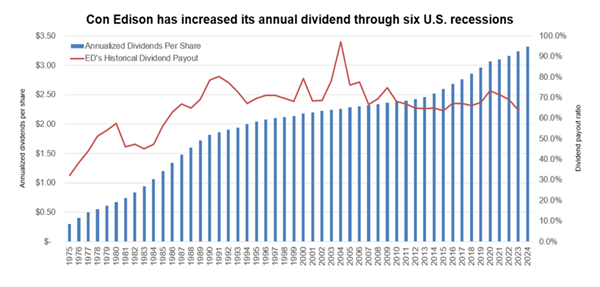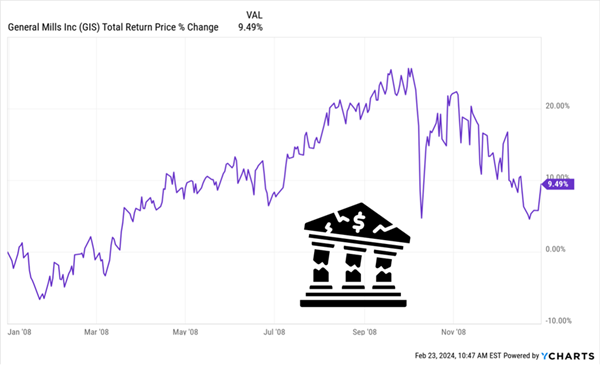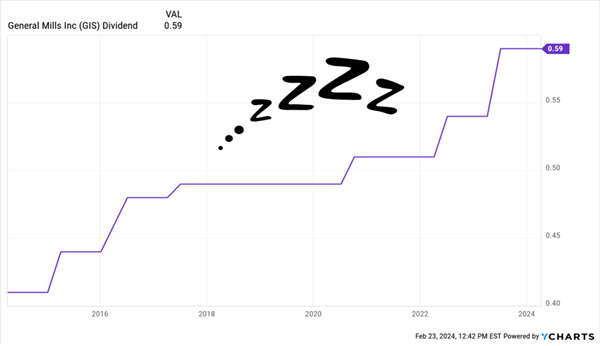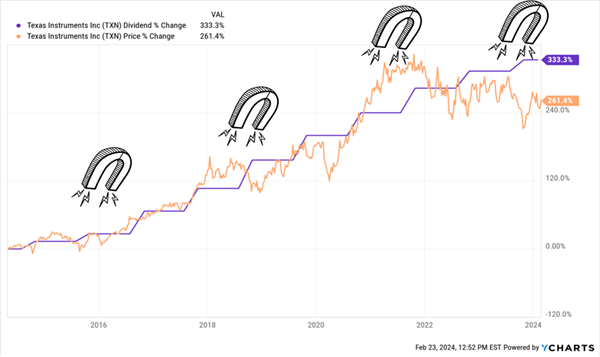You know what we’re gonna do about that hot January inflation print that dropped a couple weeks ago?
Ignore it.
Actually, we’re going to go one better and profit from it by grabbing stocks most folks see as “bond proxies”—solid companies whose stocks move up when rates come down.
But wait—isn’t that the opposite of what we should be doing when everyone is panicking that rates are going to stay high—and inflation is going to stick around?
Here’s the thing: Despite the noise, I don’t think that’s going to happen.
Truth be told, the panic we saw following the January CPI release looked like a mini version of last October’s freakout, when 10-year Treasury rates spiked to near 5% and worry was everywhere.
But we contrarians knew last fall’s panic was overdone, so we bought, adding Microsoft (MSFT) and Visa (V) to our Hidden Yields dividend-growth service on October 20.
Come January, as Joe and Jane Investor came to their senses, we sold Microsoft for a sweet 22% return. In the February issue, we issued a sell call on Visa, which left us with a 19% gain on the way out the door.
Our “October Panic Scorecard”: 2/2

Which brings us to today.
I see parallels—even if the panic isn’t as intense as it was last fall. And even if I’m wrong and inflation sticks around, it’s only a matter of time before I’m right.
In that case, the Fed may hold rates “higher for longer.” But so what? The more resolute the Fed is, the faster the economy will cool and the sooner rates will fall. And that will send folks scurrying into stocks with the two strengths we’re looking for today:
- Growing dividends, because a rising payout drives the share price higher. When rates cool off and income-seekers look to replace the income they’re getting from Treasuries, these stocks will win.
- Low beta ratings. Beta is a volatility measure. A stock with a beta of 1 trades more or less alongside the market. Betas below 1 are less volatile, while those above are more volatile. And yep, we can expect stocks with betas well below 1 to catch the eye of our volatility-allergic income seekers as the economy slows up.
The low-beta dividend growers we’re going “front run” these folks into tend to be steady revenue generators—think utilities and food stocks. With that in mind, let’s dive into two with some of the lowest betas out there.
Low-Beta Dividend Grower No. 1: Consolidated Edison (ED)
Consolidated Edison sports a five-year beta of just 0.37. That makes it only a bit more than a third as volatile as the market!
The New York/New Jersey utility behemoth—with 3.6 million electric customers and 1.1 million gas consumers—shrugs when the rest of the market tanks. Its stable share price lets us enjoy the dividend, which has risen for 50 straight years, with a compounded annualized growth rate of 5.65%, in peace.

Source: Consolidated Edison 4Q 2023 investor presentation
Further payout growth is assured, as ED expects its rate base to grow a very healthy 6.4% annually between now and 2028. And management is supporting its share-price with repurchases, having recently completed a $1-billion buyback.
Interest-rate worries have pushed down ED’s stock this year, but that just gives it more “spring” when inflation and rates move lower. Meantime, we’re getting this growing (and 3.8%-yielding) payout cheap, with the stock trading at a forward price-to-earnings (P/E) ratio of 16.6, well below the five-year average of 19.2.
“Low-Beta” Dividend Grower No. 2: General Mills (GIS)
It probably won’t surprise you to see General Mills on a list of stocks that do well when rates fall/a slowdown hits. But “the General” really must be here because its five-year beta is almost too low to be believed: 0.17!
The company’s recession-resistance is legendary—GIS was one of a very small handful of stocks that gained in the disastrous year that was 2008, and by no small amount, either:
GIS Cruised Through the 2008 Disaster

Fast-forward to now and General Mills’ sales have slowed as inflation sends more folks into the discount aisle and away from GIS’s household-name brands. That’s led management to forecast revenue to be flat to up 1% this year.
But the company’s bargain forward P/E ratio of 14.6 already reflects this. Plus, GIS’s business will likely change for the better as rates fall and inflation eases, reducing input costs and putting more money in consumers’ pockets.
And you and I both know that grocery prices are quick to rise and slower to fall, so GIS can expect higher margins as its cost increases ebb.
That all adds up to a good entry window on ultra-stable GIS now. And its dividend, which comes with a nice current yield of 3.6%, is reliable and likely to grow, with the company devoting a safe 54% of its earnings to its payout.
GIS Is a Solid Dividend Grower, But It Can’t Hold a Candle to These 5
Both of the above stocks are showing the stability and payout growth we demand at a time like this, when rate cuts are coming, but there’s still uncertainty as to when (and how many).
Trouble is, this pair is just a bit slow on the dividend-growth front for our taste.
Heck, General Mills even paused its payout hikes for three years (though it’s been working hard to catch up):
GIS’s Intermittent Payout Growth

That sudden growth spurt and the stock’s decent current yield of around 3.6% help make up for that. But we really prefer stocks whose payouts are not only growing but accelerating.
That has the knock-on effect of driving the share price higher, a phenomenon I call the “Dividend Magnet.” You can see it in effect with a name like Texas Instruments (TXN):
TXN: Dividend Up, Share Price Up

I’ve seen this “Dividend Magnet” at work time and time again. It’s why the current yield on your favorite stock never changes! And it’s working its magic on my top 5 dividend-growth stocks to buy now.
Each of these 5 stocks boast dividends that are growing at a faster and faster pace. And that’s driving their share prices higher point for point.
These are, hands down, the best stocks to own right now. Click here and I’ll take you inside my Dividend Magnet strategy and give you the opportunity to download a FREE Special Report naming all 5 of these incredible “Dividend Accelerators.”
